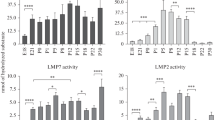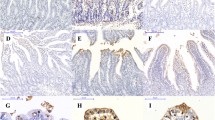Summary
Pregnant Swiss ICR mice were injected with clofibrate at different dosages and time intervals, and embryos were removed either at 17 or 18 days of gestation. In embryos sacrificed at 17 days the level of intestinal catalase activity of the proximal and distal halves in the treated groups is identical in any case to that of the controls. In embryos sacrificed at 18 days, the rise in the level of catalase activity in the proximal half of the small intestine in treated groups is dose dependent up to a certain limit: with repeated injections the increase reaches a plateau. The distal halves of treated groups are much less responsive and an increase in catalase activity was noted only with repeated injections. In untreated embryos circular DAB-positive microperoxisomes (200 nm in diameter) and tubular structures (100 nm in thickness) are seen in the duodenum at 18 days of gestation. At the same stage, only circular microperoxisomes are identified in the ileum.
After clofibrate treatment circular and tubular microperoxisomes are observed in the ileum also. It is concluded that clofibrate induces a rise in catalase activity in the embryo, only after 17 days of gestation. These observations are discussed in relation to the biogenesis of microperoxisome.
Similar content being viewed by others
References
Calvert, R., Menard, D.: Cytochemical and biochemical studies on the differentiation of microperoxisomes in the small intestine of the fetal mouse. Dev. Biol. 65, 342–352 (1978)
Calvert, R.: Study of fetal intestinal microperoxisomes in thick sections. Proc. 9th Int. Congress Electr. Microsc. (Toronto), Vol. 2, 236–237 (1978)
de Duve, C., Baudhuin, P.: Peroxisomes (microbodies and related particles). Physiol. Rev. 46, 323–357 (1966)
de Duve, C.: The peroxisome: A new cytoplasmic organelle. Proc. R. Soc. London, Ser. B 173, 71–83 (1969)
de Duve, C.: Biochemical studies on the occurence, biogenesis and life history of mammalian peroxisomes. J. Histochem. Cytochem. 21, 941–948 (1973)
de Ritis, G., Falchuk, Z.M., Trier, J.S.: Differentiation and maturation of cultured fetal rat jejunum. Dev. Biol. 45, 304–317 (1975)
Goldman, B.N., Blobel, G.: Biogenesis of peroxisomes — Intracellular site of synthesis of catalase and uricase. Proc. Nat. Acad. Sci. USA 75, 5066–5070 (1978)
Higashi, T., Peters Jr., T.: Studies on rat liver catalase. I. Combined immunochemical and enzymatic determination of catalase in liver cell fractions. J. Biol. Chem. 238, 3945–3951 (1963a)
Higashi, T., Peters Jr., T.: Studies on rat liver catalase. II. Incroporation of 14C-leucine into catalase of liver cell fractions in vivo. J. Biol. Chem. 238, 3952–3954 (1963b)
Jones, G.L., Maters, C.J.: On the turnover and proteolysis of catalase in tissues of the guinea pig and acatalasemic mice. Arch. Biochem. Biophys. 173, 463–489 (1976)
Lazarow, P. B., de Duve, C.: Intermediates in the byosynthesis of peroxisomal catalase in rat liver. Biochem. Biophys. Res. Commun. 45, 1198–1204 (1971)
Lazarow, P.B., de Duve, C.: The synthesis and turnover of rat liver peroxisomes. IV. Biochemical pathway of catalase synthesis. J. Cell Biol. 59, 491–506 (1973a)
Lazarow, P.B., de Duve, C.: The synthesis and turnover of rat liver peroxisomes. V. Intracellular pathway of catalase synthesis. J. Cell Biol. 59, 507–524 (1973b)
Lück, H.: In: Methods in Enzyme Analysis. H.H.M. Bergmeyer (ed.), pp. 885–894. Weinheim/Bergstraße: Verlag Chemie 1965
Masters, C., Holmes, R.: Peroxisomes: new aspects of cell physiology and biochemistry. Physiol. Rev. 57, 816–882 (1977)
Mathan, M., Hermos, J.A., Trier, J.S.: Structural features of the epitheliomesenchymal interface of rat duodenal mucosa during development. J. Cell Biol. 52, 577–588 (1972)
Mathan, M., Moxey, P.C., Trier, J.S.: Morphogenesis of fetal rat duodenal villi. Am. J. Anat. 146, 73–92 (1976)
Novikoff, A.B., Novikoff, P.M., Davis, C., Quintana, R.: Studies on microperoxisomes. II. A cytochemical method for light and electron microscopy. J. Histochem. Cytochem. 20, 1006–1023 (1972)
Novikoff, P.M., Novikoff, A.B.: Peroxisomes in absorptive cells of mammalian small intestine. J. Cell Biol. 53, 532–560 (1972)
Pipan, N., Psenicnik, M.: The development of microperoxisomes in the cells of the proximal tubules of the kidney and epithelium of the small intestine during the embryonic development and postnatal period. Histochemistry 44, 13–21 (1975)
Psenicnik, M., Pipan, N.: Nafenopin-induced proliferation of peroxisomes in the small intestine of mice. Virchows Arch. B Cell Pathol. 25, 161–169 (1977)
Stäubli, W., Schweizer, S., Suter, J., Weibel, E.R.: The proliferative response of hepatic peroxisomes of neonatal rats to treatment with SU-13 437 (Nafenopin). J. Cell Biol. 74, 665–689 (1977)
Svoboda, D.J.: Response of microperoxisomes in rat small intestinal mucosa to CPIB, a hypolipidemic drug. Biochem. Pharmacol. 25, 2750–2752 (1976)
Yokota, A., Nagata, T.: Ultrastructural localization of catalase on ultracryotomic sections of mouse liver by ferritin-conjugated antibody technique. Histochemistry 40, 165–174 (1974)
Author information
Authors and Affiliations
Additional information
Supported by Grant No. MA-6069 from the Medical Research Council of Canada
Mr. D. Malka was supported by a studentship from the “FCAC” of the province of Quebec
Dr. D. Ménard is a “Chercheur boursier du Conseil de la Recherche en Santé du Québec”
Rights and permissions
About this article
Cite this article
Calvert, R., Malka, D. & Ménard, D. Effect of clofibrate on the small intestine of fetal mice. Histochemistry 63, 7–14 (1979). https://doi.org/10.1007/BF00508007
Received:
Issue Date:
DOI: https://doi.org/10.1007/BF00508007




